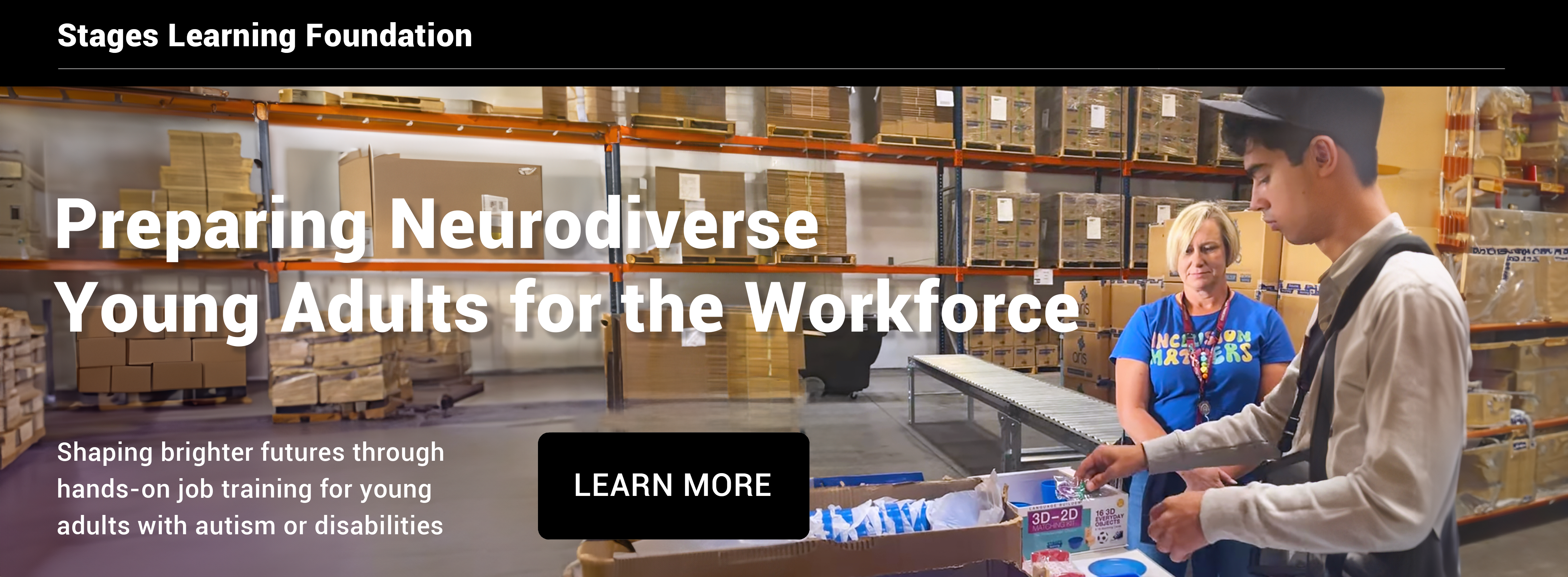Top Work Places Supporting Autistic Adults
Autistic individuals too often have been underrepresented and discriminated against in employment. A 2017 report from Drexel University found that only 14 percent of autistic adults held paid jobs in their communities. Another study found that employment rates for autistic individuals were about 25 percent lower than those for people with other disabilities. Qualified autistic job seekers are being turned away: 45 percent of autistic adults were over-educated for the job they were performing. Of the 35 percent of autistic adults with college degrees, only 15 percent are employed.
 Barriers to traditional employment like a co-existing intellectual disability, deficits in social communication, anxiety, and inflexible routines are seen as reasons why some employers might not hire autistic employees. Employers who do not hire autistic people share some similarities - a study of 69 employers found that non-hirers were focused on an employee’s ability to work in an established way, emphasized concern for negative effects, and were less open to new information.
Barriers to traditional employment like a co-existing intellectual disability, deficits in social communication, anxiety, and inflexible routines are seen as reasons why some employers might not hire autistic employees. Employers who do not hire autistic people share some similarities - a study of 69 employers found that non-hirers were focused on an employee’s ability to work in an established way, emphasized concern for negative effects, and were less open to new information.
However, a growing pool of top-performing companies and small local businesses are working actively to develop neurodiverse workforces. Employers report that autistic individuals have a stronger work ethic, a talent for work involving detail, and an eye for creative problem-solving. One CEO commented that their autistic employees achieved 48 percent to 140 percent more work than their typical colleagues. Autistic workers typically occupy task-oriented roles like stocking shelves or highly specialized roles such as software engineers. However, openings for a wider range of positions, like personal bankers and problem-resolution specialists, are increasingly being filled by autistic people. Here are six employers who are committed to building a diverse company and seeking autistic employees.
JP Morgan Chase
The initiative “Autism at Work” began in July 2015 as a four-person pilot and now employs about 85 people in 20+ roles across six countries. The expansion came from simple logic - autistic employees were 48 percent faster and as much as 92 percent more productive.
James Mahoney, a director at JPMorgan Chase, sees the big picture behind hiring autistic employees. "I firmly believe that companies could always benefit from having employees who see things in an unconventional way, which is something to remember any time an autistic individual is seeking a job."
“Our aspiration now is to get to 300 people in the program by 2020 and we’re focusing on 14 locations,” Mahoney says. “We’re also likely to expand to more locations.”
Spectrum Designs
Stella Spanakos started a screen printing company in Port Washington, Long Island so her autistic son could have an employment opportunity. Now, with more than $2 million in annual sales and a 7,400-square-foot warehouse, she employs more than 20 autistic young adults - the majority of her employees.
"I think all individuals have the right to work and the right to live up to their most full potential," says Dave Thompson, a supervisor. Spectrum Designs co-founder Patrick Bardsley says the company hopes to hire about 30 more autistic individuals to work at the facility.
Ford
“FordInclusiveWorks” developed a recruitment and transition program partnering with the Autism Alliance of Michigan. In 2015, Ford created four new positions in product development that were meant to suit the skills traditionally seen in autistic individuals. The jobs, such as logging tires used for product assessment, lasted between 30 and 90 days. All four employees then earned regular positions in the company.
Ford is planning to add up to 24 autistic individuals to its workforce in 2018. Amanda Park, a spokeswoman, concludes that “these are just good employees, filling a business need.”
ULTRA Testing
“Traditional interviews are mostly junk,” says Art Schectman, co-founder of ULTRA Testing, a software testing company with 32 employees, three-quarters of whom are autistic. The company creates hiring equity by making the interview process a demonstration of skill as opposed to a one-to-one conversation, a setting where autistic people who struggle socially or have a different communication style may not have a fair opportunity.
Co-founder Rajesh Anandan says that tapping into this overlooked talent pool is hugely successful. “One client had been working with IBM to test its new software, but ULTRA’s staff then tested the software and found 56 percent more bugs than IBM’s workers had.”
In addition to exceptional workers, Schectman credits the company’s inclusive culture for the program’s success. “Folks are serious, silly, insightful, and a whole host of other emotions that you might find anywhere else. Above all our team has a culture of collaboration over accommodation, and we are focused on creating a neurodiverse space where we embrace our differences.”
Walgreens
The “Retail Employees with Disabilities Initiative” was one of the first of its kind in 2007. Job candidates learned warehouse procedures and are then considered for jobs. Now, more than 1,500 individuals with disabilities have completed retail and customer service skills training in stores across the nation. Unlike programs that aim to capitalize on specific skills associated with autism, the aim of the Walgreens initiative is to promote employment equity regardless of ability.
Freddie Mac
Freddie Mac partnered with “Autistic Self Advocacy Network” (ASAN) in 2012 to create an Autism Internship Program with the goal of starting with the individual and identifying an opportunity within the company. Bertram Nichols, business process associate, was able to use his unique skill set.
“Doing something repetitively has always been kind of rhythmic to me,” he says. “A lot of the things I do require you to pay very close attention to what you're going through. You have to make sure you're catching every detail. Because of being autistic, I kind of have an advantage in that."
Aaron Cohen, an IT data analyst, is an example of a previously underemployed autistic person. Cohen graduated with a B.S. in Mathematics and concentration in actuarial science, but could not find work other than as a cashier. “I just wish that more companies would open up to the idea that having autistic employees isn't a liability,” he says. “It can be quite an asset.”
An autism-friendly workplace starts with a culture that values diverse skills and perspectives, and maintains structures of worker support. Among these top employers, common characteristics included using adaptive hiring process with practice interviews, offering a range of jobs beyond technology jobs, creating buy-in at all levels, training managers in neurodiversity, and partnering with job coaching firms to sustain employment.
Legitimate criticisms have been levied against some larger corporations. Shaun Bryan, an autistic writer and activist, argues that the initiatives have an “exploitative, paternalistic treatment” of their autistic employees, capitalizing on these individuals’ gratefulness for a job. Additionally, most of these initiatives target high-functioning individuals for technical careers, as opposed to creating roles for the broad spectrum. All people, regardless of ability, deserve the opportunity to contribute their unique capabilities. There’s a long way to go for companies to create job equity, but if more autistic individuals are given a seat at the table, we are headed in the right direction.
References
Baldwin, S., Costley, D., & Warren, A. (2014). Employment activities and experiences of adults with high-functioning autism and Asperger’s disorder. Journal of Autism and Developmental Disorders, 1–10.
Burgess, S., & Cimera, R. E. (2014). Employment outcomes of transition-aged adults with autism spectrum disorders: a state of the state’s report. American Journal on Intellectual and Developmental Disabilities, 119(1), 64–83.
Billstedt, E., Gillberg, I. C., & Gillberg, C. (2011). Aspects of quality of life in adults diagnosed with autism in childhood: a population-based study. Autism, 15(1), 7–20.
Bryan, S. (2018, June 21). I'm Autistic, and I Don't Support the Microsoft Autistic Hiring Program. Retrieved from https://medium.com/s/story/im-autistic-and-i-don-t-support-the-microsoft-autistic-hiring-program-and-you-shouldn-t-either-d4e5ac576dc7
Chiang, H.-M., Cheung, Y. K., Li, H., & Tsai, L. Y. (2013). Factors associated with participation in employment for high school leavers with autism. Journal of Autism and Developmental Disorders, 43(8), 1832–1842.
Integrate Autism Employment Advisors. (2018). Retrieved from https://www.integrateadvisors.org/
Lorenz T, Frischling C, Cuadros R, Heinitz K (2016) Autism and Overcoming Job Barriers: Comparing Job-Related Barriers and Possible Solutions in and outside of Autism-Specific Employment. PLOS ONE 11(1): e0147040.
Migliore, A., Butterworth, J., & Zalewska, A. (2014). Trends in vocational rehabilitation services and outcomes of youth with autism: 2006–2010. Rehabilitation Counseling Bulletin, 57(2), 80–89.
Nesbitt, S. (2000). Why and why not? factors influencing employment for individuals with asperger syndrome. Autism, 4(4), 357–369.
Newman, L., Wagner, M., Knokey, A.-M., Marder, C., Nagle, K., Shaver, D., & Wei, X. (2011). The post-high school outcomes of young adults with disabilities up to 8 years after high school: a report from the National Longitudinal Transition Study-2 (NLTS2). NCSER 2011–3005. National Center for Special Education Research.
Roux, Anne M., Shattuck, Paul T., Rast, Jessica E., Anderson, Kristy A. National Autism Indicators Report: Developmental Disability Services and Outcomes in Adulthood. Philadelphia, PA: Life Course Outcomes Research Program, A.J. Drexel Autism Institute, Drexel University, 2017.
Taylor, J. L., & Seltzer, M. M. (2011). Employment and Post-Secondary Educational Activities for Young Adults with Autism Spectrum Disorders During the Transition to Adulthood. Journal of Autism and Developmental Disorders, 41(5), 566–574.
Test, D. W., Smith, L. E., & Carter, E. W. (2014). Equipping youth with autism spectrum disorders for adulthood: promoting rigor, relevance, and relationships. Remedial and Special Education, 35(2), 80–90.
.jpg)
Emma Shanahan
Emma Shanahan is a Masters of Education candidate at the Harvard Graduate School of Education, focusing on Prevention Science and Practice. She previously taught as an elementary special education teacher in Memphis for four years, serving as a department chair for the last three. Emma is passionate about providing early intervention services to students with disabilities, as well as advocating for both parents and schools in the IEP.





